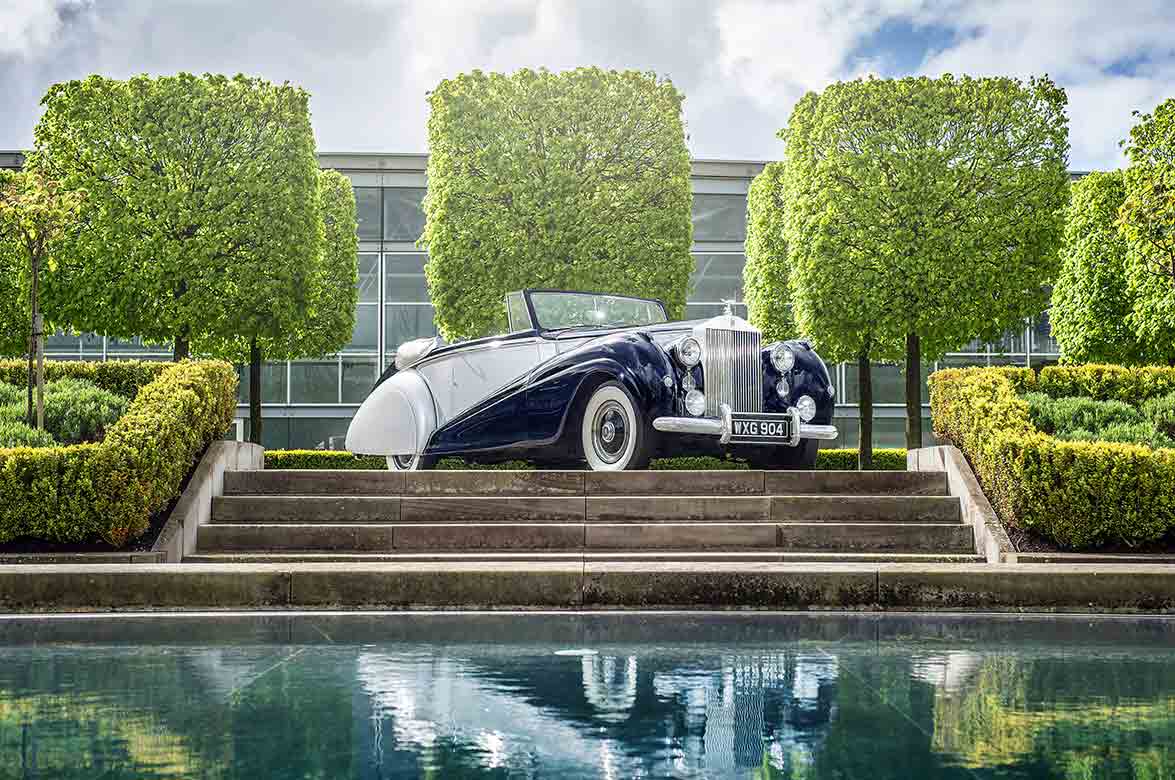2024 年 9 月 11 日
“品牌车型”系列的最新展品是劳斯莱斯银色黎明。这款车于 1949 年推出,标志着劳斯莱斯的一次深刻变革,反映了战后市场的现实。
- 1949 年推出的劳斯莱斯银色黎明简史
- 劳斯莱斯生产的第一批整车
- Silver Dawn 车型的设计、构造和工程至今仍对品牌产生影响
- 这是品牌历史上具有里程碑意义的车型系列的第五部
- 为期一年的回顾展是为了纪念亨利·莱斯和查尔斯·斯图尔特·罗尔斯于 1904 年首次会面的 120 周年
“在创立后的前 40 年里,劳斯莱斯只制造底盘,然后独立的车身制造商根据客户的要求安装车身。直到 20 世纪 40 年代末,劳斯莱斯才生产出第一辆完整的汽车 — — 银色黎明。这款车于 1949 年上市,标志着劳斯莱斯的一次重大变革,反映了战后市场的现实,同时让劳斯莱斯在产品外观设计方面拥有了前所未有的控制权。这也是第二款采用单一可变底层结构打造的车型,预示着现代所有劳斯莱斯汽车都采用的奢华架构。” 劳斯莱斯汽车
企业关系和历史主管安德鲁·鲍尔 (Andrew Ball)
尽管劳斯莱斯在 1939 年至 1945 年间暂停了汽车生产,以专注于打造航空发动机,但新车型的设计工作仍在幕后继续进行。
20 世纪 30 年代,劳斯莱斯推出了三款车型,每款车型都包含许多独有的部件,彼此之间无法共享。这大大增加了每辆车的制造成本,在战后经济紧缩时期,这一成本很快就变得难以承受。
因此,劳斯莱斯面临着在不影响质量或性能的情况下降低生产成本的问题。解决方案是新车型可以共享通用部件,新发动机可以提供直列四缸、六缸或八缸版本,以及可以配置为可变尺寸的单一底盘。后者可以看作是专有铝制空间框架的前身,被称为“豪华架构”,如今,古德伍德劳斯莱斯之家生产的每辆汽车都以它为基础。
这些想法汇集在一个开发计划中,即所谓的“合理化系列”。1946 年,劳斯莱斯推出了第一款这样的车型:Silver Wraith。这是 1936 年推出的 Phantom III 的直接替代品。与其前身以及所有战前车型一样,Silver Wraith 的底盘设计为可安装第三方定制车身。
劳斯莱斯知道,要在这个更具挑战性的时代取得商业成功,它需要一款比传统车身制造更便宜、产量更大的车型。因此,劳斯莱斯有史以来第一次决定生产整车,并在内部组装车身。就像 Silver Wraith 取代 Phantom III 一样,这款新车型将继承该品牌在过去几十年中制造的小马力汽车的衣钵。
“合理化系列”中的第二款车型 Silver Dawn 于 1949 年推出,最初仅作为出口车主要销往北美和澳大利亚市场;1952 年开始向英国客户销售。在生产的 761 辆 Silver Dawn 中,大多数都配备了内部生产的“标准钢”四门轿车车身。但为了尊重客户的要求,劳斯莱斯还提供 Silver Dawn 作为移动底盘,在持续到 1955 年的生产过程中,共完成了约 64 辆定制车型。
作为合理化系列方法的进一步证明,到 1952 年,客户可以指定带有自动档位选择的较小、完整的 Silver Dawn 和较大的 Silver Wraith 移动底盘。事实上,Silver Dawn 将是最后几款配备手动变速箱的劳斯莱斯车型之一。半个多世纪后,卫星辅助八速 ZF 自动变速箱才问世,如今所有 V12 劳斯莱斯汽车都搭载这种变速箱,但命运已成定局。在
Silver Dawn 的使用寿命即将结束时,当时新聘用的 John Blatchley 重新设计了它的后部,他在加入劳斯莱斯之前曾师从著名的伦敦车身制造商 Gurney Nutting 学习手艺。他对细节的敏锐洞察力不仅增加了行李容量,还大大提升了汽车的外观;也许这并不奇怪,他后来成为了该品牌的首席造型工程师。2015 年,Dawn 重新焕发活力,到 2023 年停产时,它已成为劳斯莱斯历史上最畅销的敞篷车。这款
“最年轻”的 Silver Dawn 现已问世近 70 年。但即便是现在,在现代交通条件下,它仍能为驾驶员提供令人振奋的体验,为长途旅行的乘客提供轻松的旅程。从任何意义上来说,它都是一辆纯粹的劳斯莱斯。
MODELS OF THE MARQUE: THE 1940s THE ROLLS-ROYCE SILVER DAWN
11.09.2024
The latest in the ‘Models of the Marque’ series showcases the Rolls-Royce Silver Dawn. Launched in 1949, it marked a profound change for Rolls-Royce, reflecting the realities of the post-war market.
- A brief history of the Rolls-Royce Silver Dawn, launched in 1949
- The first complete motor cars ever produced by Rolls-Royce
- Silver Dawn models’ design, construction and engineering still influences marque today
- Fifth in a series celebrating landmark models from the marque’s history
- Year-long retrospective marks the 120th anniversary of the first meeting between Henry Royce and The Hon. Charles Stewart Rolls in 1904
“For the first 40 years of its existence, Rolls-Royce built only rolling chassis, onto which independent coachbuilders installed bodywork specified by the client. It wasn’t until the late 1940s that the marque produced its first complete motor car – the Silver Dawn. Launched in 1949, it marked a profound change for Rolls-Royce, reflecting the realities of the post-war market while giving the marque more control than it had ever enjoyed over the exterior design of its products. It was also the second model to be built on a single, variable underlying structure, foreshadowing the Architecture of Luxury upon which all Rolls-Royce motor cars of the modern era are built.”
Andrew Ball, Head of Corporate Relations and Heritage, Rolls-Royce Motor Cars
Although Rolls-Royce suspended motor car production between 1939 and 1945 to focus on building aero engines, design work on a new model continued in the background.
During the 1930s, Rolls-Royce offered three models, each of which included numerous parts that were unique to it and could not be shared between them. This significantly increased the manufacturing costs per car, which quickly became unsustainable during the austerity of the post-war years.
Rolls-Royce therefore faced the problem of reducing production costs without compromising quality or performance. The solution was new models that could share common parts, a new engine that could be offered in straight-four, six or eight-cylinder variants, and a single chassis that could be configured in variable dimensions. The latter can be seen as a precursor of the proprietary aluminium spaceframe, known as the Architecture of Luxury, that underpins every motor car built at the Home of Rolls-Royce in Goodwood today.
These ideas came together in a development programme for what would be known as the ‘Rationalised Range’. In 1946, Rolls-Royce launched the first such model: the Silver Wraith. This was a direct replacement for Phantom III, introduced in 1936. Like its predecessor, and indeed all the pre-war models, Silver Wraith was a rolling chassis designed to be fitted with third-party, coach-built bodywork.
Rolls-Royce knew that to be commercially successful in these more challenging times, it needed a model that was less expensive and could be produced in greater numbers than was possible with traditional coachbuilding. So, for the first time in its history, Rolls-Royce decided to produce a complete motor car, with coachwork assembled in-house. In the same way that Silver Wraith replaced Phantom III, this new model would assume the mantle of the small-horsepower cars the marque had built in previous decades.
The second model in the ‘Rationalised Range’, the Silver Dawn, was launched in 1949, initially only as an export car mainly for the North American and Australian markets; it became available to UK clients in 1952. Of the 761 Silver Dawns produced, most were supplied with the ‘Standard Steel’ four-door saloon bodies produced in-house. But in deference to clients’ requirements, Rolls-Royce also offered the Silver Dawn as a rolling chassis, with some 64 coach-built examples completed in a production run that lasted until 1955.
As further proof of the Rationalised Range approach, by 1952, clients could specify both the smaller, complete Silver Dawn and larger Silver Wraith rolling chassis with automatic gear selection. Indeed, Silver Dawn would be among the very last Rolls-Royce models to be offered with a manual transmission. It would be more than half a century before the advent of the satellite-aided, eight-speed ZF automatic transmission fitted to all of today’s V12 Rolls-Royce motor cars – but the die had been cast.
Towards the end of its lifespan, Silver Dawn’s rear section was reworked by the then newly hired John Blatchley, who had learned his craft with renowned London coachbuilder Gurney Nutting before joining Rolls-Royce. His deft eye for detail not only allowed for greater luggage capacity, but also enhanced the motor car’s looks considerably; perhaps not surprisingly, he would go on to become the marque’s Chief Styling Engineer. In 2015, the nameplate was revived with Dawn, which was the best-selling drophead in Rolls-Royce’s history by the time production ended in 2023.
The ‘youngest’ Silver Dawn is now almost 70 years old. Yet even now, it offers an exhilarating experience for the driver and a restful ride for passengers over long distances in modern traffic conditions. It was and is, in every sense, entirely a Rolls-Royce.

